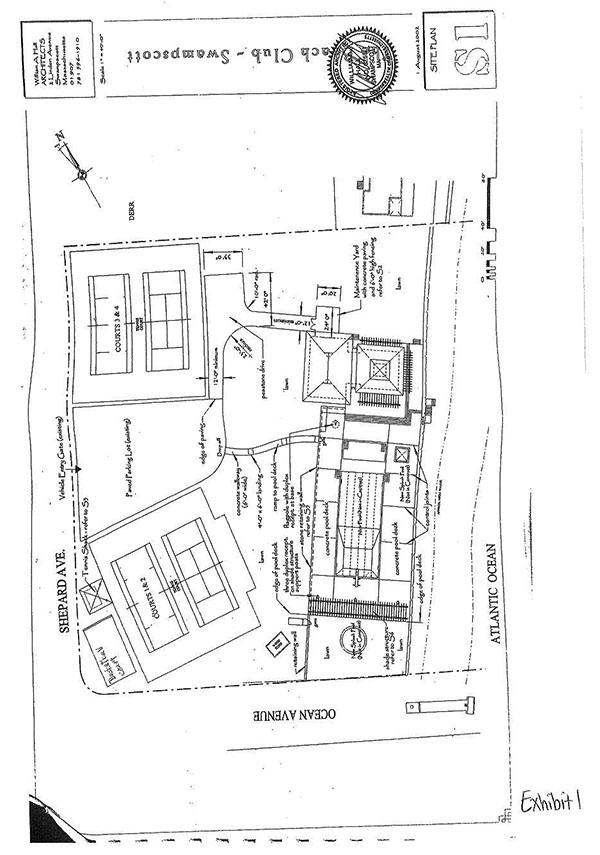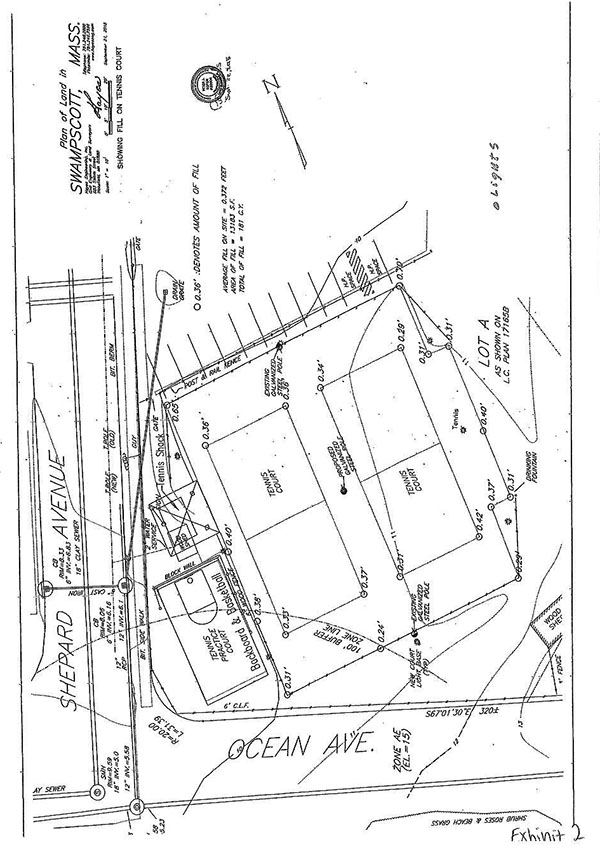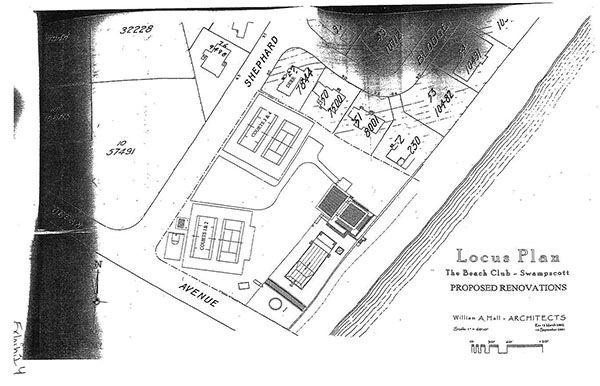Introduction
As its name suggests, The Beach Club, located on the ocean on Shepard Avenue in Swampscott, is a private recreational facility with a beach, clubhouse, pool, and outdoor tennis courts. The Club is a non-conforming use with non-conforming structures in a neighborhood restricted to single-family residences, and was allowed to expand to its current size and configuration, including the addition of more outdoor tennis courts, only because of the grant of special permits in the past. [Note 1]
Defendant Jo Ann Simons Derr lives next to the tennis courts and is particularly affected by the noise and other impacts from their use. Neither the past special permits, nor the plans incorporated into those permits showing and restricting the work they allowed, [Note 2] reflect or show any lighting for the courts, and there has been no such lighting in the past.
On March 13, 2015, the Club applied for a building permit to "resurface existing tennis courts and install new lights at courts #1 & 2" - specifically, nine 20-foot-tall galvanized steel poles with light fixtures attached to their tops on 2-foot-high curved mounting arms. [Note 3] On March 31, 2015, the town's building inspector issued the requested building permit. Ms. Derr, with the support of numerous other neighbors, appealed the building permit to the zoning board of appeals and, on July 2, 2015, the board unanimously (5-0) reversed the building inspector and revoked the permit.
This case is the Club's G.L. c. 40A, §17 appeal from the board's decision. In brief, the Club contends that the lights can be installed as a matter of right. Ms. Derr and the board disagree, contending that either a new special permit or a modification of the prior one - neither of which was applied for, nor obtained - would be necessary for the installation of the lights.
There are no material facts in genuine dispute, and the board has now moved for summary judgment. For the reasons set forth below, the board's motion is ALLOWED and the Club's appeal from the board's decision revoking the building permit is DISMISSED, WITH PREJUDICE.
Facts
"Summary judgment is appropriate when, viewing the evidence in the light most favorable to the nonmoving party, all material facts have been established and the moving party is entitled to a judgment as a matter of law." Regis College v. Town of Weston, 462 Mass. 280 , 284 (2012) (internal quotations omitted). A fact is genuinely in dispute only if "the evidence is such that a reasonable jury could return a verdict for the nonmoving party." Anderson v. Liberty Lobby, Inc., 477 U.S. 242, 248 (1986). Material facts are those that might affect the outcome of the case under the governing law. See id. at 248. See also Mulvihill v. Top-Flite Golf Co., 335 F.3d 15, 19 (1st Cir. 2003); Hogan v. Riemer, 35 Mass. App. Ct. 360 , 364 (1993).
The following facts are not in genuine dispute.
The Club and Its Surrounding Neighborhood
The Club is located on the ocean at 80 Shepard Street in Swampscott. It currently consists of a beach, club house, a large pool, two splash pools, four tennis courts, a basketball court, a small outdoor wooden shed, and a tennis shack (pro shop). See Ex. 1. It is in a single-family residential district which prohibits such clubs. See Zoning Bylaw, §2.2.3.0 (District A-1). The site has been used as a beach and tennis club since 1928, however, and that use is thus protected as a pre-existing, non-conforming use pursuant to G.L. c. 40A, §6 and zoning bylaw §2.2.7.0.
Past Permits
The Club was previously smaller in size, and was expanded in the past under two special permits. [Note 4] The first, in 1979, allowed the construction of two new tennis courts in addition to the previous two, conditioned on their not being used before 8:00 a.m. See Use Permit (Apr. 2, 1979). The second, in 2002, allowed a large expansion of the clubhouse, an expansion of the pool, the addition of two new splash pools, the addition of a pool deck and shade structure, and the construction of a tennis pro shop. See Special Permit (Oct. 3, 2002). [Note 5] Eleven of the surrounding neighbors opposed the permit, [Note 6] primarily because of noise, and the permit was ultimately granted only on its "strict adherence to the conditions and restrictions listed [in the board's decision], and that "any failure of compliance will entitle the neighbors to seek all remedies and sanctions available in situations involving a violation of the Town's Zoning By-Law including,
without limitation, the right to petition [the zoning board] for limitations on the restrictions." Special Permit (Oct. 3, 2002) at 3. Those conditions included the requirement that "[a]ll construction shall be in accordance with the plans" submitted to the board and identified in the decision. None of those plans showed any lighting on the tennis courts. See Ex. 1 and Joint Statement of Agreed Facts, ¶13 ("The specified plans referenced in the Zoning Board of Appeals 2002 Special Permit Decision did not include any lighting structures for any of the Property's tennis courts."). There was also a condition that all activities at the Club must cease by no later than 9:00 p.m., with the exception of ten special events a year which could run until 11:00 p.m.
The Building Permit at Issue
On March 13, 2015, the Club applied for a building permit to resurface each of its four tennis courts and to install nine, 20-foot-high galvanized steel poles, with light fixtures on curved mounting arms attached to their tops, to illuminate two of them. See Ex. 2. The estimated cost of the work was over $97,000.
The building inspector issued the requested permit on March 31, 2015. On April 27, 2015, Ms. Derr appealed the building permit to the zoning board of appeals contending, among other things, that the light poles were structures, that the addition of the lights violated the 2002 special permit which, in her view, implicitly limited tennis to daylight hours, and that they also constituted a change of use insofar that tennis could now be played at night. The Club disagreed, contending that the lights could be installed as a matter of right. By unanimous (5-0) decision, the board revoked the permit. The board's decision was filed with the town clerk on July 2, 2015, and the Club timely filed this appeal pursuant to G.L. c. 40A, §17.
Analysis
The light poles are clearly "structures" regulated by the town's zoning bylaw. [Note 7] The bylaw provision on outdoor lighting only addresses the requirements for such lighting if it is otherwise allowed; it does not itself allow compliant installation as of right. [Note 8] Thus, the question for decision is whether the conditions of the 2002 special permit or, independent of that decision, the limitations of grandfathering, require either a modification of the 2002 special permit or an entirely new special permit for installation of the tennis court lights. On the undisputed facts, as a matter of law, I find and rule that they do.
The Club disagrees, arguing, in essence, as follows. Under G.L. c. 40A, §6, it can proceed with the installation of the lights as of right unless their effects will be "substantially more detrimental than the existing nonconforming use to the neighborhood." The only such potential effects would be (1) light, or (2) noise. If the light poles comply with §3.4.2.0 of the bylaw, the Club says, there will be no light impacts on the surrounding neighborhood or, at the least, a material issue of fact as to whether there will be, precluding summary judgment. As to noise, the Club contends that the hours of operation specified in the 2002 Special Permit are the board's recognition that no substantial detriment will be caused by Club operations, including tennis, during those hours, and the addition of lights to the tennis courts will not extend them.
For purposes of summary judgment, I assume that there will be no light impacts on the surrounding neighborhood. I thus need not, and do not, reach that issue. The impact of noise is more than sufficient to affirm the board's decision revoking the building permit.
I begin by noting the obvious. Tennis courts produce noise. Tennis entails calling balls "in" or "out", and the voice making the call must be loud enough to carry across the court. If the game being played is "doubles", constant verbal communication between teammates is required. Tennis players, and those watching the play, are enthusiastic. Players congratulate each other. Spectators clap, cheer, and shout their encouragement. The noises produced by the game itself are not steady, ambient background. Instead, they are sharp, discrete, and irregular - the "thwock" of the racket hitting the ball, and the squeak of tennis shoes on the court as players rush back and forth. All of this is particularly noticeable in the still, night air, with none of the usual daytime sounds to mask it. All of it is spontaneous and effectively uncontrollable - an inevitable part of the game, and a good part of what makes it fun.
I continue by noting what is also obvious. Putting lights on a tennis court extends the hours of play into twilight and darkness, beyond what they would otherwise be without illumination. Why else have lights? And the evening and nighttime hours are when sounds are most apt to be bothersome, coming at a time when quiet is most prized.
Did this impact, at these times of twilight, dusk, and darkness, exist before? The answer, of course, is "no." None of the Club's tennis courts have ever been lighted. Adding lights, and thus allowing play to continue into the hours of twilight, dusk, and darkness, is thus a substantial extension of what existed before. Is the impact such that a special permit is needed? The board, in revoking the building permit, thought so, and "it is the board's evaluation of the seriousness of the problem, not the judge's, which is controlling." Wendy's Old Fashioned Hamburgers of N. Y v. Board of Appeal of Billerica, 454 Mass. 374 , 382 (2009) (internal citations and quotations omitted). In any event, I concur.
The Club's contention that the prior special permit decisions by the board have already determined that this nighttime noise is not "substantially more detrimental" than the pre-existing use, and thus now allowable by building permit alone, is simply wrong. The 1979 Use Permit, which prohibited tennis games before 8:00 a.m. but did not set a closing hour, did not do so because no such closing hour was deemed necessary. The courts were not illuminated, and no illumination was proposed. Play would naturally end as the bright daylight ended. The 2002 Special Permit allowed the Club to operate between 8:00 a.m. and 9:00 p.m., but this was premised on the Club facilities as set forth in the plans so approved. See Special Permit (Oct. 3, 2002) ("All construction shall be in accordance with the plans prepared by Hayes Engineering...."); Ex. 1 (approved site plan). None of those plans showed any illumination of the tennis courts. Joint Statement of Agreed Facts, ¶13 (Apr. 11, 2016). The noise from play on those courts thus ended with the end of daylight, and the 9:00 p.m. closing time for the rest of the Club's activities cannot be read as approving a subsequent extension of tennis hours into the night. Simply put, it was not an issue before the board. As the board's current decision revoking a building permit issued without a special permit finding clearly shows, had such a possible extension been raised, it would have been addressed explicitly.
Conclusion
For the foregoing reasons, the board's decision revoking the building permit for construction of the tennis court light poles is AFFIRMED and the Club's appeal from that decision is DISMISSED, WITH PREJUDICE. Because the lights would allow tennis to be played into the hours of darkness, because such play had never before occurred, and because the noise impacts from such play are a substantial extension of the prior impacts, the board was correct that either a modification of the prior special permits, or a new special permit, is required before they may be installed.
Judgment shall enter accordingly.
(emphasis added). The zoning bylaw in effect at the time tracked the statutory language.
[b]uildings, structures or signs may not be erected, substantially altered, moved, or changed in use and land may not be substantially altered or changed with regard to size or shape or principal use without written certification by the Inspector of Buildings that such action is in compliance with then applicable zoning, and that all necessary permits have been received under federal, state, or local law. Issuance of a Building Permit or Certificate of Use and Occupancy, where required under the Commonwealth's State Building Code, may serve as such certification.
Zoning Bylaw, Art. V, §5.1.1.0.
All exterior lighting, except municipal street lighting, shall be shielded so as not to cast light directly on adjacent streets or properties. The lighting source shall be shielded from view from adjacent roadways and properties. The level of illumination of lighting shall be low so as to reduce the glow of ambient light perceptible on adjacent properties. All exterior lighting shall also comply with other applicable requirements of this By-Law, for example, Sections 3.1.5.2 [parking lot design] and 3.2.2.0 [signs] above.
For purposes of summary judgment, I assume that the proposed tennis court lighting complies with this provision.
 THE BEACH CLUB INC., v. DANIEL DOHERTY, HARRY PASS, ANTHONY PAPROCKI, ANDREW ROSE and DOUGLAS DUBIN as members of the Zoning Board of Appeals of the Town of Swampscott, and JO ANN SIMONS DERR.
THE BEACH CLUB INC., v. DANIEL DOHERTY, HARRY PASS, ANTHONY PAPROCKI, ANDREW ROSE and DOUGLAS DUBIN as members of the Zoning Board of Appeals of the Town of Swampscott, and JO ANN SIMONS DERR.



